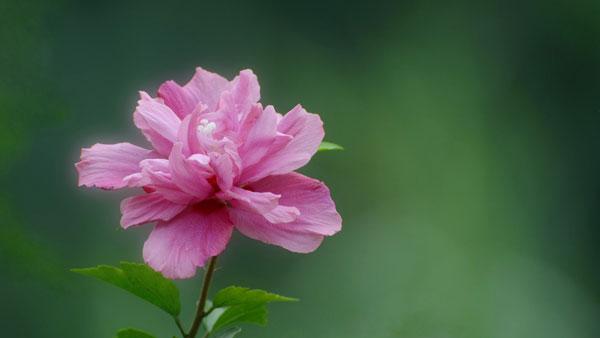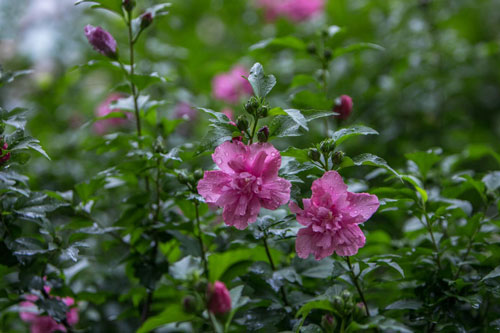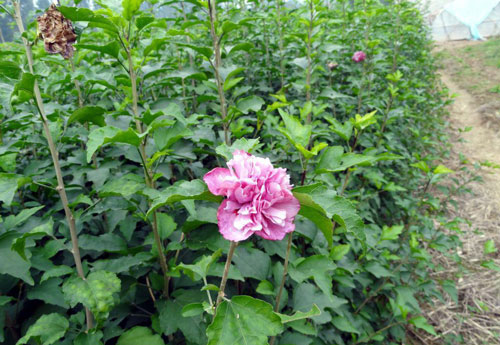Reasons For No Rose Of Sharon Flowers
Written by Iris
Jul 16 2021

The Salon Rose (Hibiscus syriacus) is a flowering shrub that grows in urban gardens and is known for its large number of beautiful hollyhock-like flowers that appear over a long period of time --from early summer to frost. It can reach a full height of 12 feet and spread 10 feet. An erect deciduous shrub commonly known as the althea or hardy hibiscus, the salon rose has cup-shaped flowers that bloom from late summer to fall. The flowers are blue, pink, red, purple, white and lavender.
These shrubs are planted for flowering, and without them, the plant would be normal. But the common problem with the Salon rose is that it has many buds but no flowers at all. This is no reason to panic and abandon the bush. While it may be too late to rectify the problem during the current growing season, there are some simple steps you can take to rectify the situation and ensure an adequate flowering season next year.
The Normal Blooming Habit
The blooms of Rose of Sharon, also known as shrub althea, are most welcome since they come during the latter half of the summer and into fall when most flowering shrubs have finished flowering. In most regions where rose of Sharon thrives, the flowers are best in July and August. This makes it especially disappointing when the flowers don't come at all, or when the plants have numerous buds but they never bloom.
Reasons For No Rose Of Sharon Flowers
There are many possible answers as to why buds on your rose of Sharon flower do not open, but the most common causes are related to shade, rot, or overwatering, and drought:
- Excessive shade: Rose of Sharon will not bloom up to its full capabilities if given too much shade.
- Rot: During rainy summers, rot can set in and ruin the flower buds, although this may not be noticeable from the outside. The same effect can be produced by excessive watering if you water overhead. A rose of Sharon planted in dense, poor-draining soil can also develop rot.
- Drought: During dry summers, rose of Sharon flower buds can be damaged from drought and fail to open.
- Inadequate phosphorus. As a nutrient, phosphorus assists a plant in its ability to update nutrients from the soil. If the soil is deficient, the plant's buds may fail to open
- Inappropriate or inadequate pruning. Rose of Sharon blooms on new growth, and if the shrub is pruned at the wrong time, you may have removed the buds.
- Pests or disease. Aphids, in particular, can cause buds to soften and fail to open. In this case, the flower buds will likely feel soft and spongy and may rot. A number of other fungal diseases may also cause bud failure.
How to Deal With Problems

Watering Issues
When watering your rose of Sharon, always direct the water toward the soil around the plant rather than onto the plant itself. If you spray high, you will drench the flower buds, which invites rot. Of course, rain will soak the flower beds from overhead, and you have no control over that. But if your shrub is properly located in full sun the sunlight will help dry the water off the buds after a rainfall.
Drought
The problem of drought is the most straightforward issue to correct. Simply keep your plant adequately watered during the summertime, and make an extra effort during periods of drought. How much water should you give your rose of Sharon? The exact amount (and the precise frequency of watering) depends on the conditions. For this reason, rather than trying to put a number on it, just remember this: The soil around your plant should be kept evenly moist. Gently dig down 6 inches into the soil and feel it with your hand. The soil should feel neither dry nor soaked, but slightly moist. If it is dry to the touch, provide at least 1 inch of irrigation water, preferably apply directly to the soil rather than sprayed from overhead.
Phosphorus Deficit
Rose of Sharon normally does not need much feeding, but if you notice the size or profusion of blooms dwindling, it may indicate a phosphorus deficiency in the soil, which is preventing the plant from properly converting the other available soil nutrients. A general-purpose fertilizer can correct mild deficiencies, or you can scratch in an organic bone meal fertilizer into the soil around the plant. Amounts you apply should be modest, as too much phosphorus can stunt the entire plant.
Improper Pruning
If you are not seeing even flower buds on your plant, it's possible you have pruned incorrectly. Because this plant flowers on new growth wood, if you pruned too close to flowering time, you will remove the new wood from which the buds and flowers appear.To enhance blooming and promote larger blossoms, prune the shrub each spring, retaining only two to three buds on each branch. Remove dead, diseased and damaged branches constantly to help the blooms flourish and keep the plant healthy overall. Prune away up to one-third of the oldest branches to rejuvenate the rose of Sharon. Look for thicker stems, cutting those branches at the base.
Pests and Diseases
Pests should be visible to close inspection. Aphids, the most common pest, will usually be visible on stems or the underside of leaves; buds may feel soft, and if peeled open, they may show rot. Neem oil or insecticidal soaps are safe ways to combat aphids and other insects. Fungal problems usually occur because of overhead watering or lack of air circulation. Pruning the shrub to improve airflow between the branches may help. Or, use fungicidal powder to combat fungal disease.An organic spray will help eliminate these pesky critters. Make your own organic spray by mixing 1 cup of vegetable or white mineral oil, 2 cups of water and 2 teaspoons of dish soap. Place the mixture in a spray bottle. Spray insects every one to two weeks. Aside from organic spray, nature's own defense, the ladybug and other beneficial insects, can be deployed to get rid of aphids.
Shade Issues
The problem of excessive shade is relatively easy to solve, especially if you are able to exercise some forethought. This is a plant for full sun. When you are planting the shrub, make sure that you choose a location that receives at least 6 hours of direct sunlight per day. If you have planted it in an area that is too shady, consider transplanting the shrub to a more suitable location. Alternately, other surrounding plants can be moved or trimmed to improve the sun exposure. Shade trees, for example, can be trimmed to remove lower branches that shade the plant.
Latest Updated
- Benefits of Bugleweed - 7 Science-backed Health Benefits
- Bugleweed Dangers & Side Effects - Is It Poisonous?
- How to Plant Evergreen Trees - What You Should Know
- When to Plant Evergreens - Grow Guide for Evergreen Trees
- 12 Wonderful Evergreen Shrubs for Your Garden
- 12 Popular Evergreen Plants with Pictures for Beginners
- When And How To Prune A Lilac Bush Like a Pro
- How to Grow & Care for Lilac Vine (Hardenbergia Violacea)
- Japanese Lilac Tree (Syringa Reticulata) Care & Propagation Guide
- Shumard Oak Pros and Cons - What to Know
Popular Articles
- Winter maintenance of Antirrhinum Majus
- How to Grow Terminalia Mantaly Tree
- How to Grow and Care for Crossostephium Chinense
- How to grow Antirrhinum Majus in spring
- Peristeria Elata (Dove Orchid) Profile: Info & Care Guide
- Underwatered Snake Plant (Sansevieria Trifasciata) - Signs And How To Fix
- How to Care for Brazilian Jasmine Plant (Mandevilla Sanderi)
- How to Grow & Care for Graptopetalum Purple Delight in Summer
- Rosa Chinensis (China Rose): Plant Growing & Care Tips
- How to Care for Baby Sun Rose (Aptenia Cordifolia)